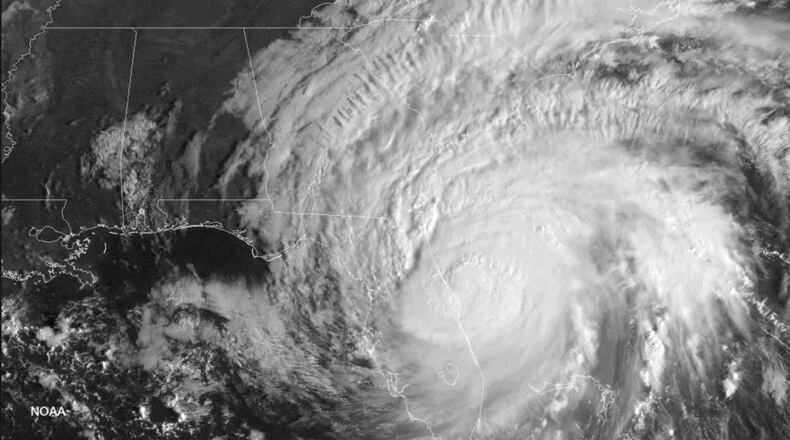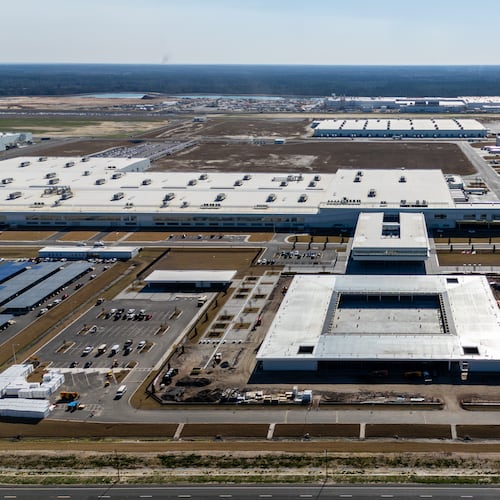The Atlantic hurricane season officially started June 1. Georgia and other coastal states could face a historic number of storms.
In May, the National Oceanic and Atmospheric Administration released its 2024 seasonal hurricane outlook, predicting more storms for a single season than ever.
“The key this year, as in any year, is to get prepared and stay prepared,” said NOAA Administrator Rick Spinrad.
Forecasters predict between 17 and 25 named storms, up to 13 of which could become hurricanes. Up to seven of those could become major hurricanes ranked Category 3 or higher on the Saffir-Simpson Scale. NOAA said it’s about 70% confident in these ranges.
It’s a concerning number. But experts said coastal residents shouldn’t panic because it’s too early to predict exactly where those storms will go.
“It doesn’t matter whether there’s one storm or 50,” said Savannah-based hazard expert Chuck Watson, founder of Enki Research. “If that one storm hits you, it’s a bad year.”
An unprecedented forecast
NOAA’s monster forecast for the 2024 hurricane season is based on two main factors: the atmosphere and the ocean temperature.
Forecasters predict a La Niña atmospheric cycle will start in the Pacific Ocean later this summer. Reduced wind shear in the Atlantic, or the speed and direction of the wind, creates ripe conditions for hurricanes to form. More storms typically spin up in La Niña years.
Meanwhile, the surface of the Atlantic Ocean and the Gulf of Mexico is extraordinarily warm, thanks largely to the warming climate. Warm water acts like fuel for tropical weather systems, which means the storms that do happen this year have a good chance of getting stronger – and fast. Some of the strongest storms strengthen quickly as they approach land.
Speaking to reporters, National Weather Service director Ken Graham commented on the sobering forecast.
“We have a responsibility, all of us. Let’s keep everybody calm out there,” he said “Because we’ve been through a lot across the country, a lot of storms.”
Georgia’s risk factors
According to Colorado State University, 140 named storms and 51 hurricanes impacted Georgia from 1880 to 2020.
CSU issues a seasonal forecast similar to NOAA’s. It also expects an above-average season. Using a combination of historical data and an index known as Accumulated Cyclone Energy, researchers say there’s an 82% chance this year that Georgia will be impacted by a named storm. That’s compared to an average 63% chance. “Impact” is defined as one or more storms within 50 miles of the state’s borders.
Watson’s own hurricane model estimates the likelihood of individual global locations experiencing hurricane-force winds. Based on the same forecast conditions NOAA looked at and what actually happened in past years with similar conditions, Georgia’s largest coastal city, Savannah, is likelier than average to see a storm this year. But Watson still preached calm.
“You should not be any more worried this year than you were last year, even though the odds were half,” he said. “The bottom line is, whether it hits you is what matters.”
Graham echoed the same sentiment during NOAA’s press conference: “It only takes one storm close to you to make it a busy season,” he said.
Experts also stressed another important point: it doesn’t take a direct hit to experience damage or danger.
For example, in 2016, Hurricane Matthew skimmed by Georgia, only 50 miles from its shores. According to the National Hurricane Center, parts of coastal Georgia experienced Category 1 winds of at least 74 miles per hour and flooded three to five feet above ground level. At least 300,000 people lost power. Two people died as a direct result of the storm.
“It’s about the impacts, not the category,” said Graham.
The Saffir-Simpson scale, which meteorologists use to rate hurricanes, is based only on wind speeds. The most intense winds can be found in a hurricane’s eyewall. However, hurricanes are cyclones that spin counter-clockwise, meaning communities grazed by its outer bands can still experience significant rainfall and other hazards.
Graham said one of the most dangerous factors is water. Even weak hurricanes and other named storms can dump massive amounts on a city and flood roads, homes, and businesses.
At that point, drowning deaths become a concern. Coastal communities can experience several feet of storm surge. But even communities further inland are at risk. From 2013 to 2023, Graham said 90% of storm fatalities resulted from water. About two-thirds of those died from freshwater flooding. Half of that number died in cars.
“It’s preventable,” said Graham.
Prepare but don’t panic
There’s a major flaw in early-season hurricane forecasts like NOAA’s, Watson said: they’re incomplete.
“The variables that we do know how to forecast look pretty bad,” he said. “But that’s only about half the picture.”
Watson said it’s too soon to predict the conditions that determine where storms go once they form or whether dry winds from Africa will stymie monster storms. Climate change also makes those factors harder to forecast, adding more uncertainty.
The National Hurricane Center issues weekly outlooks throughout the season, summarizing the storms they’re monitoring and the places where new ones could form. The key language to watch for, Watson said, is “interests in Georgia should monitor the storm.” That means there could be impacts here, ranging from rough seas and rip currents off the coast to strong winds, heavy rainfall, and flooding.
At that point, local leaders are typically watching the storm, too. They will start issuing updates via social media and local alert apps advising people what to expect and when and recommending steps to stay safe. Once a storm forms and starts moving, forecasters can examine in up-to-date detail the various factors that drive where it goes and how strong it gets.
Regardless of the number of storms that do affect Georgia this year, officials want you to start preparing now.
The first step is to make an emergency plan with your family. This doesn’t just apply to hurricanes; a plan is important in other natural and manmade disasters. The Department of Homeland Security offers a free template. Consider your family’s specific needs and set a meeting place should you get separated. It’s also practical to have important information, like phone numbers and insurance coverage, on paper and not rely only on electronic devices.
Second, make an emergency kit. It should contain enough food, water, and other goods to sustain your family for a few days. Officials recommend building this kit little by little over time. It is less expensive than buying a big haul and prevents shortages when a storm is coming and everyone is flocking to stores.
It’s also important to check your home or renter’s insurance to make sure it’s up to date and includes flood protection, Watson said, because once a storm is approaching it’s usually too late to add coverage.
Lastly, know where to get accurate, reputable information. During disasters, misinformation can run rampant on social media. Ensure you get your information from official channels or trusted media outlets. GEMA is Georgia’s statewide emergency management agency, and the National Hurricane Center is the country’s official source of hurricane forecasting. Most counties also have their own emergency managers, who can provide more specific advice and updates.
“It only takes one storm to devastate a community, and it’s prudent to prepare now because once the storm is headed your way,” Spinrad said, “it all happens so rapidly you won’t have the time to plan and prepare at that point.”
Credit: Grist
Credit: Grist
MEET OUR PARTNER
This story was originally published by our partner Grist, a nonprofit media organization covering climate, justice, and solutions. Sign up for their newsletter here.
If you have any feedback or questions about our partnerships, you can contact Senior Manager of Partnerships Nicole Williams via email at nicole.williams@ajc.com.
Keep Reading
The Latest
Featured




